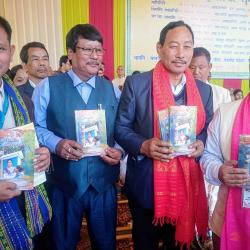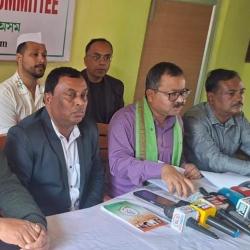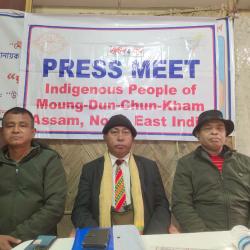If the Burha luit could speak, it would definitely clamour about its abundance and endurance. It for a river is obsolete in today’s legislative terminology as rivers are getting humanised. Probably river mystics are waking up from the deep slumbers after decades of industrial pollution, riverbank erosion and siltation around the river valley. Wonder how the psyche of people is played around the river on grounds of religious territorialism and a mirage of development along the river banks. The Burha luit has always been a treasure for the people who live along its banks both for the gains of grains, prosperity and mobility and also for the losses of lives, livelihoods and land. In Assam people have always entwined their lives according to the whims of the river course, depth, resources and reminiscences offered by the living traditions attached to India’s longest river Burha Luit or Brahmaputra. We have grown up writing essays on floods, Brahmaputra, livelihoods along the river and the richness of soil which is settled in the riverbeds adequate for the flora and fauna of Assam. During the monsoons the rivers plays havoc on people with sleepless nights and loss of lives, livestock, property and livelihoods. But the same river brings the boon of alluvial soil, rich vegetation and good health for people along its banks all year round. Rivers are the elixir of life and such rivers are restored with adequate measures which would keep its flow alive and never stop the course of the river. Burha Luit has always been an inspiration for the fisher-folk, boat-riders and travellers across its banks and also for the artists and literary figures whose paintings, songs, dance forms, articles and poetry have always kept the river alive and awake. There are famous songs of Dr. Bhupen Hazarika like Bistirna parore..., Jilikabo Luitor Paar..., Jyoti Prasad Agarwalla’s Luitor Paarore Ami Deka Lora..., Parvati Prasad Baruva’s songs like Luitor saporit kore naworiya... have immortalised the essence, emotions and attachments of the people of Assam with the mighty Burha Luit and its innumerable tributaries. The river lived in the heart and soul of every person who lived, thrived, travelled, survived and struggled along with the tides and turns of this enormous resource defining the identity of Assam and its people.
I have grown up along the upper most banks of luit across Dihing, Dikhow and Dhansiri rivers and then travelled through the Luit, Barak, Kolong, Kopili, Pagladia, Aie along Dhemaji, Lakhimpur, Sonitpur, Darrang, Kamrup, Nalbari, Baksa, Chirang, Kokrajhar, Dhubri, Goalpara, Nagaon, Majuli, Umrangsu, Jatinga, Cachar, Karimganj in livelihood pursuits. Sometimes during floods, otherwise during regular days and even during acute drought season where one could walk across the banks. The river seems to hold my grit together every year to face its wrath, adore its fascinating beauty and enjoy its serenity. The river has its own flow frothing and fuming during heavy monsoons and soothing during spring and autumn and drying up during winters. In Dhemaji, the river changes course thrice in the year. Any work which is done alongside the river does not hold ground as the river decides the might not humans. I am just wondering with humanising the river, how such might will be tamed. Human beings do not respond to their needs but more profusely to their greed. Luit has always taken care of people’s needs but never their greed. The river has 4 bridges along its banks Saraighat, Goalpara, Koliabhumura and now in Dhemaji. The river is already bordered with embankments and spars which are routed along its North and south banks to irrigate, regulate the flood waters and also to reduce the impact of erosion. It has huge hydro-electric dams sites across the downstream from Pagladia to Subansiri which have high risk factors keeping in mind very high seismic zones. Burha Luit is alive and adored by the people as a source of livelihood, life and living identity more than being an incarnation of one particular religious sect. Its pristine glory and resources are still intact because of minimal human industrial interventions along its banks. But with the recent shifts and oil exploration missions, dam sites and further plans of riverbed dredging the Burha Luit seems to be pushed beyond its natural limits which could backfire on the crops, aquatic life, people and the heritage sites along the river.
Before getting into clandestine deals for profit, promotion and prayers on and along the Burha Luit, the hidden, covert and unknown impact assessments and ecological implications needs to be in public discourse, discussion and debate. Festivities do not hold any ground for all those who lose their children, crops, parents, friends, neighbours, livestock and treasured resources every year to the devastating floods. Religious branding of the river will not answer the ahoy calls of people crying for help when their granaries, house roofs, older, immobile and sick family members are drowning during the floods, when their minor girls have to sell their bodies to feed their siblings on National Highways, when the soil patches of large fragments gets eroded in the river, when youths are drowned in the river due to coercive activities, when the young men from riverine communities migrate from Assam to be security guards in metropolitan cities of Indian sub continent, when endangered animals float dead during floods and do not find any safe space. Already the people of Assam have traded its oil, gas, tea, jute, bamboo, paper, wildlife, people and now the latest is the river, all in the name of festivities, religious ritualism and divisive mono-cultured politics. Hope the river decides its own discourse, restoration plan and regeneration processes and makes way for life along its banks. Thus spoke Burha Luit...before it was diminished to a human spirit.
- 9286 reads










Add new comment